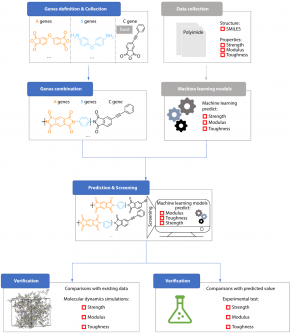Top Stories
AI Breakthrough Accelerates Design of Tough Polyimide Films

BREAKING: A groundbreaking AI-assisted materials-genome approach has been unveiled by researchers at the East China University of Science and Technology, dramatically accelerating the design of ultra-tough polyimide films. This innovative method, reported online on September 2, 2025, addresses critical challenges in the aerospace and electronics industries where polyimides are essential for their thermal stability.
The new strategy utilizes machine learning to predict and optimize three key mechanical properties—Young’s modulus, tensile strength, and elongation at break. This is a game-changer as traditional methods have been slow and costly, often leading to compromises in mechanical performance. The research team has identified a new formulation, named PPI-TB, which outperforms established benchmarks such as PETI-1 and O-O-3.
Using advanced Gaussian process regression (GPR) models, the team trained their system on over 120 experimental datasets, exploring a vast chemical space of 1,720 phenylethynyl-terminated polyimides. The predictive accuracy of the models was impressive, achieving an R² value of approximately 0.70–0.74 for all three mechanical metrics. This allowed for comprehensive screening of candidates, leading to the successful identification of PPI-TB, which demonstrated a remarkable modulus of 3.48 GPa.
The implications of this research are significant. By transforming polymer fragments into genetic-like descriptors, the scientists have created a framework that allows for rapid exploration of material possibilities. Prof. Li-Quan Wang, a leading author of the study, emphasizes, “Machine learning not only predicts performance but also reveals which chemical ‘genes’ are driving it.” This innovation could reduce the time and cost associated with developing new materials, potentially revolutionizing the polymer industry.
The integration of AI with molecular design not only streamlines the material discovery process but opens up new avenues for creating the next generation of high-temperature polymers. This approach is expected to have far-reaching benefits, from enhancing microelectronics to improving aerospace composites.
In addition, the methodology could be adapted for other high-performance polymer classes, facilitating the development of lightweight, durable, and thermally stable materials. This research was supported by the National Key R&D Program of China and the National Natural Science Foundation of China.
In a world increasingly reliant on high-performance materials, the urgency for advancements like this is clear. The successful application of this AI-driven strategy marks a pivotal moment in polymer science, one that promises to shape the future of aerospace, electronics, and beyond.
For further details, refer to the full study published in the Chinese Journal of Polymer Science. This innovative research is set to redefine the landscape of material science and engineering in the years to come. Stay tuned for more updates on this developing story.
-

 Business1 week ago
Business1 week agoIconic Sand Dollar Social Club Listed for $3 Million in Folly Beach
-

 Politics2 weeks ago
Politics2 weeks agoAfghan Refugee Detained by ICE After Asylum Hearing in New York
-

 Health2 weeks ago
Health2 weeks agoPeptilogics Secures $78 Million to Combat Prosthetic Joint Infections
-

 Science1 week ago
Science1 week agoResearchers Achieve Fastest Genome Sequencing in Under Four Hours
-

 Lifestyle2 weeks ago
Lifestyle2 weeks agoJump for Good: San Clemente Pier Fundraiser Allows Legal Leaps
-

 Health2 weeks ago
Health2 weeks agoResearcher Uncovers Zika Virus Pathway to Placenta Using Nanotubes
-

 World2 weeks ago
World2 weeks agoUS Passport Ranks Drop Out of Top 10 for First Time Ever
-

 Business2 weeks ago
Business2 weeks agoSan Jose High-Rise Faces Foreclosure Over $182.5 Million Loan
-

 Entertainment2 weeks ago
Entertainment2 weeks agoJennifer Lopez Addresses A-Rod Split in Candid Interview
-

 World2 weeks ago
World2 weeks agoRegional Pilots’ Salaries Surge to Six Figures in 2025
-

 Science2 weeks ago
Science2 weeks agoMars Observed: Detailed Imaging Reveals Dust Avalanche Dynamics
-

 Top Stories1 week ago
Top Stories1 week agoChicago Symphony Orchestra Dazzles with Berlioz Under Mäkelä









